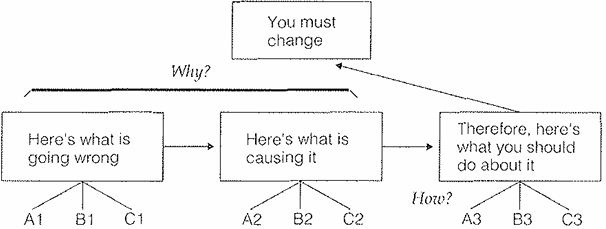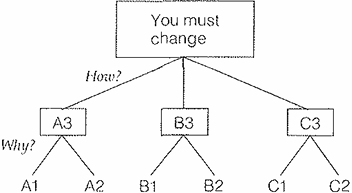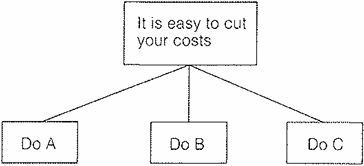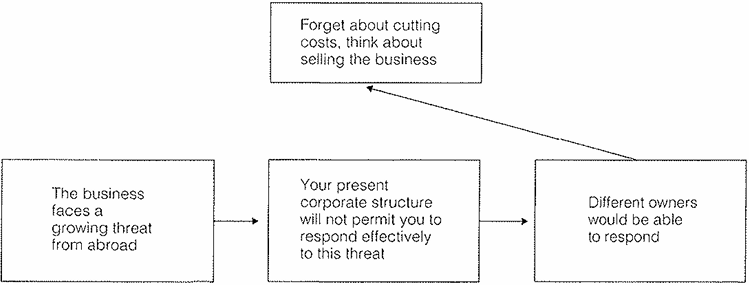


 Grammar
Grammar
 Tenses
Tenses
 Present
Present
 Past
Past
 Future
Future
 Parts Of Speech
Parts Of Speech
 Nouns
Nouns
 Verbs
Verbs
 Adverbs
Adverbs
 Adjectives
Adjectives
 Pronouns
Pronouns
 Pre Position
Pre Position
 Preposition by function
Preposition by function 
 Preposition by construction
Preposition by construction
 Conjunctions
Conjunctions
 Interjections
Interjections
 Grammar Rules
Grammar Rules
 Linguistics
Linguistics
 Semantics
Semantics
 Pragmatics
Pragmatics
 Reading Comprehension
Reading Comprehension|
Read More
Date: 2024-09-09
Date: 2024-09-15
Date: 4-3-2022
|
This slow-moving approach leads me to urge that, on the Key Line level, you try to avoid using a deductive argument, and strive instead always to present your message inductively. Why? Because it is easier on the reader.
Let's look at what you force the reader to do when you ask him to absorb a deductively organized report. Suppose you wish to tell him that he must change in some way. Your argument would look something like this:

To absorb your reasoning, the reader must first take in and hold the A-B-Cs of what is going wrong. I agree this is not a difficult task, but then you ask him to take the first A of what is going wrong, bring it over and relate it to the second A of what is causing it, and then hold that in his head while you make the same match for the Bs and Cs. Next you ask him to repeat the process, this time tying the first A of what is going wrong to the second A of what is causing it, and hauling the whole cart load to hitch to the third A of what to do about it. And the same with the Bs and Cs.
Not only do you make the reader wait a very long time to find out what he should do Monday morning, you also force him to reenact your entire problem-solving process before he receives his reward. It is almost as if you're saying to him, "l worked extremely hard to get this answer and I'm going to make sure you know it." How much easier on everybody were you simply to present the same message inductively:

Here, instead of answering the "Why?" question first and the "How?" question second, you simply reverse the order: And now, while you may indeed have deductive arguments at the lower levels, still you have answered the reader's major question directly, with clear fences in your thinking between subject areas, and all information on each subject in one place.
But isn't deductive reasoning stronger and tighter than inductive, people usually ask me. Not at all. It is all the same reasoning; we are only discussing how to lay it out on the page.
To explain it another way, at the end of the problem-solving process you will have come up with a set of ideas that can be sorted onto a Recommendation Worksheet like that shown in Exhibit l9. The worksheet permits you to visualize the fact that you have gathered findings that led you to draw conclusions from which you determined recommendations.

These designations-findings, conclusions, recommendations-though widely used, are actually something of a misnomer. There is in fact no difference between a finding and a conclusion, other than a rather arbitrary labeling of level of abstraction. The summary of a group of findings is always a conclusion. Thus, you will have a set of findings and conclusions to support what is going wrong, and another set to support what is causing it.
In order to have come to these clusters of conclusions, you will have had to use three types of reasoning: induction, deduction (both of which you know about), and abduction. Abduction, as you can see in Appendix A, Problem Solving in Structureless Situations, occurs when you make a hypothesis and look for information to support it. But of course once you have the information, the reasoning becomes induction.
Your reasoning as laid out in the worksheet is complete-the only decision is how to present it. If you want to present the message deductively, you lay it out one column at a time, as shown on the previous page. If you want to present it inductively, you simply turn the whole thing 90 degrees to the left and put the recommendations on the Key Line, with the appropriate finding/conclusion grouped underneath.
The issue here is whether it is better to tell the reader why he should change and then how to go about it, or that he should change and why each change makes sense. As a rule of thumb, it is always better to present the action before the argument, since that is what the reader cares about, unless you face one of those rare cases in which it is the argument he really cares about.
When might the argument for any action be more important to the reader than the actions themselves? When the point you are making at the top of the pyramid is alien to the kind of thing he expects you to say. For example, imagine the following dialogues:
Situation 1
Him Tell me how to cut my costs
You It is very easy to cut your costs
Him How?
You Do A, do B, do C
Obviously here we would want a standard inductive pyramid.

Situation 2
Him Tell me how to cut my costs
You Forget about cutting costs, you should be thinking about selling this business
Him Why? How? Are you sure? Good God'
Here you clearly need a deductive argument.

The only other time I can think of when you automatically know you need a deductive argument at the Key Line level is when the reader is incapable of understanding the action without prior explanation, as in David Hertz's article on how to do risk analysis that we looked at earlier. Here the reader needed to know the reasoning that underlies the analytical approach before he could understand the actual steps in the approach.
Few of the recipients of business documents fall into either class, however, so that in general you will find yourself wanting to structure the Key Line of your pyramid to form an inductive argument. Note that I am talking only about the Key Line here, and not about lower levels. Deductive arguments are very easy to absorb if they reach you directly:

When, however, you must plough through 10 or 12 pages between the first point and the second, and between the second and the third, then they lose their instant clarity. Consequently, you want to push deductive reasoning as low in the pyramid as possible, to limit intervening information to the minimum. At the paragraph level deductive arguments are lovely; and present an easy-to-follow flow; but inductive reasoning is always easier to absorb at higher levels.
If you do decide to use deductive reasoning at the lower levels of your pyramid, there are some permissible types of chained argument, beyond the basic syllogistic form, of which you should be aware (Exhibit 20).


The only rules to bear in mind in chaining deductive arguments are that (a) you cannot have more than four points in a deductive argument, and (b) you cannot chain together more than two "therefore" points. Actually, you can do both if you want to (the French philosophers do so all the time), but the groupings will be too heavy to summarize effectively. So if you wish to make proper summaries, you must limit your deductive groupings to no more than four points.
|
|
|
|
للعاملين في الليل.. حيلة صحية تجنبكم خطر هذا النوع من العمل
|
|
|
|
|
|
|
"ناسا" تحتفي برائد الفضاء السوفياتي يوري غاغارين
|
|
|
|
|
|
|
نحو شراكة وطنية متكاملة.. الأمين العام للعتبة الحسينية يبحث مع وكيل وزارة الخارجية آفاق التعاون المؤسسي
|
|
|